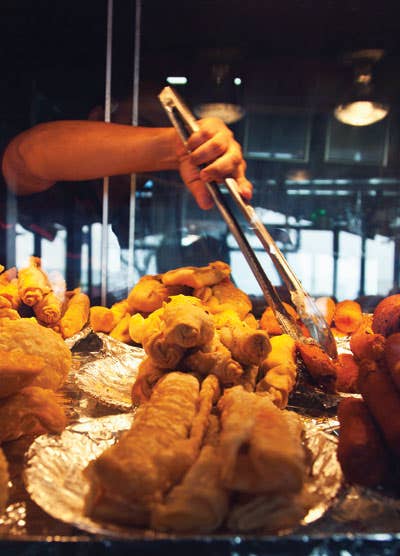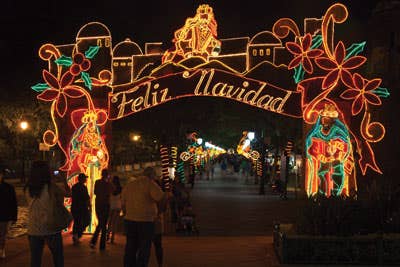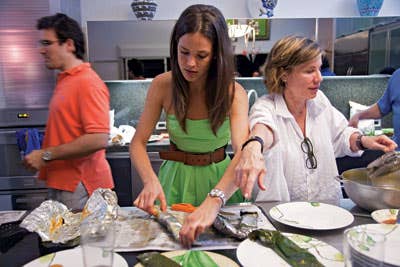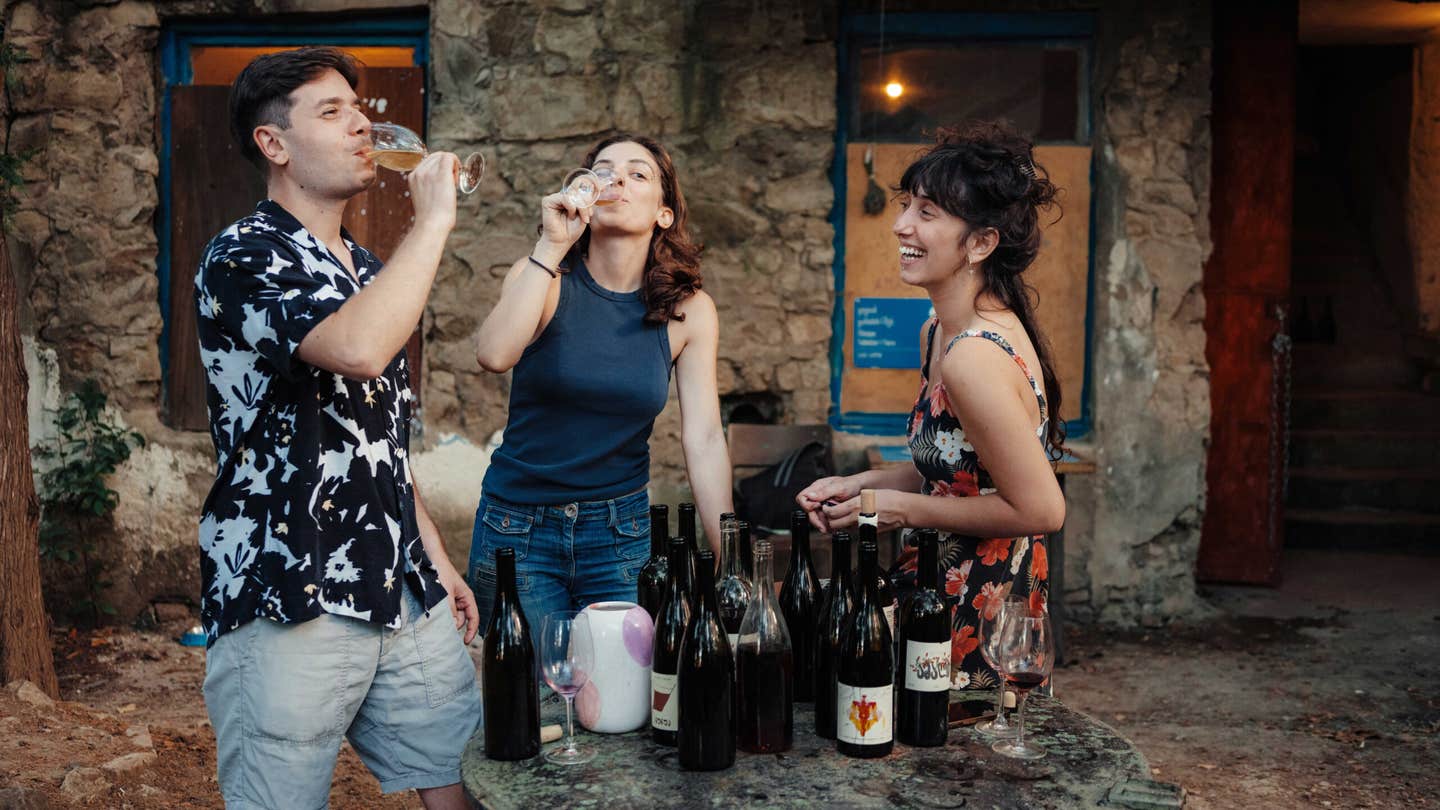
Island Holiday: Christmas in Puerto Rico
In Puerto Rico, Christmastime brings a series of joyous, satisfying feasts
Growing up in New Jersey, Christmas always meant snow, cozy fireplaces, chestnuts, and Santa Claus. But my idea of the holidays changed in 1990, the first year I spent them with my then boyfriend, Ronnie Rodriguez, and his family at their home in San Juan, Puerto Rico. I was 23 years old, sunburned, mosquito-bitten, and feeling out of place at their annual Christmas Eve celebration, called Nochebuena. I remember trying to identify all of the dishes on the sprawling buffet: yellow rice with brownish-green pigeon peas; platters of glistening roast pork and black-as-night blood sausage studded with rice; bowls filled with round and oblong fritters. As I placed a small banana leaf bundle on my plate, I heard whispers coming from Ronnie's great aunts, Rosita and Goyin. "Mira! She's eating our food!" said Goyin, who had years of experience with her own sons' gringa girlfriends and their skittish ways at the table. "Do you think she knows what pasteles are?" wondered Rosita aloud.
I had no idea, but they struck me as seasonally appropriate—little green parcels made from banana leaves, so neatly wrapped they looked like they belonged under a Christmas tree. I found out later that they are the quintessential Puerto Rican holiday food—tamales made from green banana or plantain and yautia (a starchy locally grown tuber) that are so labor-intensive to prepare, you find them only on special occasions.
I unraveled the package on my plate. Inside was a deliciously sweet golden plantain paste, flavored with smoky pork, briny olives, and a hint of dried fruit, moister and more complex than any tamales I'd ever eaten. I caught Rosita and Goyin smiling as I enthusiastically unwrapped another. From that day forward, pasteles became my favorite holiday dish, and soon, that season became my favorite time to visit Puerto Rico.
No one prolongs the holidays like Puerto Ricans: I realized this once Ronnie and I were married and started spending much of the Christmas season on the island. The celebration begins at Thanksgiving, kicking off two months of parties, both scheduled and spontaneous. The festivities gain momentum on Nochebuena and pick up steam on the way to New Year's; minor religious holidays like Dia de los Inocentes (December 28) are celebrated with parades in the countryside and family meals. But the real climax of the season is Dia de los Reyes, or Three Kings' Day, on January 6, which is followed by Octavitas, religiously known as "eight days of admiration," but commonly referred to as "one more week to party." Fiestas de la Calle San Sebastian, a three-day Mardi Gras—style street festival, closes out the holidays in mid-January.
Ronnie's family has lived in Puerto Rico since their ancestors arrived from Spain in the 19th century, and they embrace the spirit of the season. I'll never forget the first time I was jolted out of bed in the middle of the night by a noisy parranda—a crowd of carolers singing traditional Spanish songs and threatening not to move on until invited into Ronnie's home for food and drink. Or learning to save an appetite for two dinners on Nochebuena: first at my father-in-law's, then at Ronnie's aunt's apartment. New Year's was marked by a party at the home of his uncle, Tio Richard, who always arranged a visit by trovadores, sharp-tongued musicians who improvised songs about the family.
But it's the novelty of Three Kings' Day that I adore most of all. On its eve, children leave a shoebox full of hay out for the Magi, who ostensibly trample through the house on camels during the night to leave gifts. In the morning, the kids awaken to find strewn hay and upturned furniture. The adults feign outrage, while the children, still amazed by the miracle they had just witnessed, run to the gifts awaiting them. Later in the day, Ronnie's family heads to the countryside for yet another gigantic meal.
From family to family, feast to feast, the menu is usually the same. Typically, there's an assortment of frituras, like codfish fritters (called bacalaitos), and tostones, rounds of twice-fried green plantains. Guests gather around a buffet that features pasteles; arroz con gandules, rice cooked with pigeon peas; guineos en escabeche, pickled green bananas; morcilla, an intensely flavored, ebony-colored sausage made from pigs' blood and rice; and the main events—lechon, a whole spit-roasted pig, its juicy flesh encased in an outer layer of fat and crackling skin, and sometimes a pavochon (turkey seasoned and cooked in the style of the pork). Dessert is always tembleque, smooth coconut custard, and coquito, the rich Puerto Rican eggnog, made with coconut milk and rum.

photo by Penny de los Santos
How could I not love this food? The African, European, and Caribbean catalog that makes up cocina Criolla, as Puerto Ricans call it, is full of guilty pleasures—starchy vegetables, fatty meats, and all manner of things deep-fried. Many of my now-favorite indulgences are in season over the holidays, like jueyes, sweet and briny blue land crabs, stewed with a fragrant mix of tomato, garlic, pepper, and onion, and lerenes, a water chestnut—like corn root, eaten boiled with a sprinkling of salt. But others are available year-round. The pig, for example, rules in Puerto Rico. It's in everything—ham hocks enrich stews; pork belly flavors rice; cracklings made from rendering lard add depth to mofongo, a hearty plantain mash. It's a beast so celebrated that several towns across the island boast stretches of road lined with restaurants that specialize in lechon, whole-roasted young pigs. (See Pork Is King)
It was an obsessive admiration for this food that led me to volunteer to host last year's Three Kings' Day feast at my mother-in-law's country home in Canovanas, up in the Sierra de Luquillo mountains, just a 30-minute ride from San Juan. I looked at it as payback for two decades as a party guest, but also as a way to chip away at my gringa status. And when I vowed to do it as traditionally as possible, my mother-in-law happily handed over the reins.
Ronnie's family is enormous: three half siblings, two step siblings, seven aunts and uncles, 23 first cousins, and too many extended (but just as dear) relatives to count. It was from this clan that I assembled my dream team of cooks, knowing full well that cooking for 70 was not a job for one person. Ronnie's first cousin Julie Carrion, 36, born in San Juan, is a talented caterer whose training brought her through the kitchens of chefs like Anita Lo and Daniel Boulud in New York City. Mario Ormaza, 30, the boyfriend of another first cousin, was my next recruit. He'd studied at the Culinary Institute of America, but more important, he knew pig. He knew where to source it. He knew how to season it. And he knew how to spit-roast the 95-pounder we'd be serving at the feast.
Fritter duty went to Ronnie's aunt Maresa Rodriguez, or Titi Mare as we call her, 72, who taught me to appreciate Puerto Rico's fried delights on countless road trips throughout the island, stopping off at one beachside kiosko after the next. And cousin Roxana Matienzo, a 50-something attorney and author, agreed to show me how to make pasteles, something she'd learned from her parents. "We make a party of the whole process," Roxana told me.
A few days before the feast, I found out what she meant. A slew of cousins joined in and we sipped champagne as we peeled green bananas and yautia for the pasteles' filling in Roxana's kitchen. The palm trees outside fluttered as aguinaldos, traditional Christmas songs, blared through the speakers. Neighbors and relatives wandered in and out to have a drink and lend a hand.
After the green bananas and yautia had been pureed and blended with milk to make a smooth masa, we hacked banana leaves from Roxana's garden and boiled them until pliant. We added her signature touches to the filling—marcona almonds, palm dates, chickpeas, and olives. Then we fell into an assembly line. We cut the banana leaves into squares, placed them on foil, and brushed them with achiote oil. Down the line, we filled them with green banana and yautia paste; added the sauteed pork filling; and then folded them into perfect rectangles. We pinched the foil tight before tying them with string. Brush, fill, fold, tie. We did this about ten dozen times. As a reward for our hard work, we boiled a test batch for ourselves and enjoyed them in the garden as night fell.

photo by Penny de los Santos
The following day, Julie and I made a final shopping trip for the feast at the Plaza del Mercado in Santurce, a 19th-century market building in a residential part of the capital, which houses a dozen or so of the city's best produce vendors. We hauled out our bounty, stopping to order a couple of mango batidas (shakes) from a fruit stand outside the Mercado, then drove to my mother-in-law's home, where Julie, Ronnie, and I cooked late into the night, serenaded by a chorus of chirping coquis, the musical tree frogs of the island. We knocked holes into coconuts, extracted the water, and opened a stubborn few by slamming them on the ground. We scooped out the meat, then grated and strained it to make coconut milk. We set some of the milk in the fridge to thicken into tembleque, the dessert, and mixed the rest with condensed milk, eggs, and rum for coquito. Next, we peeled and boiled green bananas until they had the perfect al dente texture and marinated them with red onion, olives, and sherry vinegar for guineos. We made an enormous amount of sofrito--the base to practically every rice, soup, and stew in Puerto Rican cuisine—which is an essential component in many of our holiday dishes. Ours was a slow-cooked blend of onion, sweet and hot aji peppers, garlic, oil, and plenty of culantro, a robust herb with a deeper flavor than its cousin, cilantro. As the sofrito cooked down, taking on a deeply sweet aroma, I reflected on how these ingredients, which I once considered so foreign, were now as familiar to me as Ronnie and his family.
The next morning we were awakened by Mario's truck horn, which he was excitedly honking. He had arrived with the hulking pig that would be the centerpiece of our meal, tied to a spit, in the back of his pickup. He had purchased our lechon two days earlier from a farmer in nearby Trujillo Alto, and then seasoned it by cutting slits under the legs and stuffing them with garlic, salt, pepper, and oregano. To further flavor and tenderize the pig, he rubbed the rest of it with sour orange juice, squeezed from an especially tart variety of citrus called naranja agria that he'd picked from trees in his garden.
A handmade galvanized-steel smoker waited on the grass for Mario to load with coal, which he placed at strategic corners at the bottom. "You start cooking near the legs, at the ends, then move the coal over to the middle," he told me, "because you don't want the ribs and loin to overcook." He lit the coals, and about 20 minutes later, the pig was placed in the box; he covered the top with corrugated metal, then sat vigilantly by its side for the next six hours, turning the pig from side to side to release its grease and distribute its juices.
The smell of coal and pork wafted into the kitchen as Julie and I got to work on the arroz con gandules, cooking the rice in a caldero, or cast-iron pot. We dressed the dish with sour orange vinaigrette; put the pasteles on to boil; let the guineos sit at room temperature; grated some coconut on top of the tembleque; and shook the coquito until frothy.
Titi Mare came soon after and started in on the frituras as more family arrived. It was a beautiful Puerto Rican winter's afternoon: The sun was shining, the sky was blue, the temperature was a mild, breezy 80 degrees. Titi fried up almojabanas, rice-flour rounds with cheese; her son Felipe's signature croquetas de pollo, with a creamy chicken center; and yautia, the densest fritura of the bunch. I shuttled them to the guests, who were welcoming each other with hearty embraces. Ronnie tended bar, doling out wine, Cuba libres, and short glasses of coquito.
When the pig was ready, Mario butchered the browned beast, and we laid the food on a buffet table. The cuerito (brown crispy skin) and the ears were the first to go. The loin was juicy, the ribs sublime. The guineos had the perfect acidic sting; the pasteles were golden as we unfolded their wrapping. I was proud of our feast: The rice went quickly, and family members scraped up the pegao, the coveted crispy bits at the bottom of the pot. The tembleque tasted as fresh as a newly opened coconut.
As the party wound down, I poured myself a glass of wine and took my spot at the domino table. I had earned a reputation as a formidable player, schooled by the family champions over the years. As the sun set, and laughter rose over the clack-clack-clack of the tiles, my mother-in-law made a toast to me for a successful party. I recognized her approving smile. She had inherited it from her aunts, Goyin and Rosita, the very ones who marveled two decades prior at my embracing of their nephew, their culture, and cuisine—pasteles and all.
Keep Reading
Continue to Next Story










